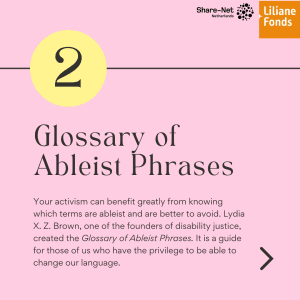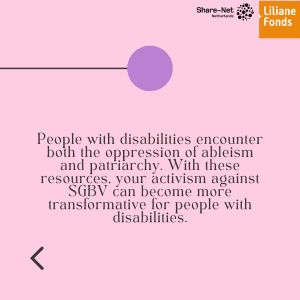By Marieke van Gerwen, SRHR Advisor and Daphne Visser Advocacy and SRHR Advisor at Liliane Fonds
Children with disabilities are 4.6 times more likely than children without disabilities to experience sexual violence (WHO, 2021). Similarly, according to Handicap International (2015), a substantial proportion of young women with disabilities will encounter sexual violence before the age of 18.
The exclusion of persons with disabilities from society and Sexual and Gender-based Violence (SGBV) are both rooted in analogous systems of oppression. SGBV arises from the abuse of power, disrespect, and inequality between the perpetrator and the survivor. This is true for all instances of SGBV, but these factors are intensified when the survivor has a disability. Persons with disabilities often depend on the support of others, which can lead to a power imbalance. Additionally, the lack of accurate information in society results in misinformation about persons with disabilities. There is a stigma of dependence and an expectation that persons with disabilities are incapable of performing tasks that those without disabilities can. The mistaken belief that a person with disabilities cannot marry, have children, engage in sexual activity, or earn an income, places them at risk of disrespect and, consequently, sexual violence.
Regrettably, the challenges do not end there. After experiencing SGBV, persons with disabilities face greater obstacles in the justice system compared to those without disabilities. This is due to the fact that justice systems worldwide are not sufficiently adapted to, or designed for, individuals with impairments. Physical and communication barriers, as well as stigma from staff, play a role.
To address this, it is crucial to raise awareness. It is, therefore, increasingly important that our advocacy against SGBV includes a disability justice lens. As a beginner disability activist, this might sound daunting. Rest assured; we got your back! With these 5 resources you can start your disability activism journey today.
First-Person Stories from the Twenty-First Century

First up, is for the readers. Disability Visibility: First-person stories from the twenty-first century edited by Alice Wong is a collection of essays which “show disabled people simply being in our own words, by our own accounts”. It is a heavenly read with essays spanning the themes of being, becoming, doing, and connected. Each essay confronts, in its own way, the ableist society we are living in today and allows those of us who are not confronted by it every day to learn around topics such as the disability community, institutionalization, beauty standards and crip theory. Each essay can be read separately, allowing for learning and reflection at your own pace.
Transform your language to be more inclusive and anti-ableist with this insightful guide
Ableism also rears its ugly head in the way we speak and the words we use. Language is power. Your activism can benefit greatly from knowing which terms are ableist and are better to avoid. Lydia X. Z. Brown, one of the founders of disability justice, created the Glossary of Ableist Phrases. It is a guide for those of us who have the privilege to be able to change our language. Her blog, even though discontinued, is also an amazing resource on disability Justice and worth a read on its own account.
Amplifying Voices Through Podcasts

Thirdly, we have a listening suggestion for you. In the Make Way for Youth podcast. Vilda, Bertha and Warindi dive, together with their guests, deeper into topics related to sexual rights and intersectionality. In their episodes Leave No One Behind Part 1 and Leave No One Behind Part 2, they are joined by Steven Jethro Phiri. Jethro is a programme officer at the Zambia Federation of Disability Organisations (ZAFOD), a true organization of people with disabilities. In the episodes, he shares about his work and the importance of inclusive advocacy and programmes for young people with disabilities.
Practical tips for making protests, mobilizations, and events inclusive for all.
If you are well known on the streets, organizing and mobilizing, you might have been wondering how to make your protest or mobilization more accessible. Sins Invalid has been at the forefront of the disability justice movement and has created resources full of access suggestions for your mobilization or events. Give them a read!
Join a network of passionate individuals and organizations committed to advancing disability justice.

Last but not least, if you feel inspired to learn more about disability justice, collaborate with people with a passion for disability rights and justice, or are just looking for a community to support you as a disability activist, you can join the Community of Practice on Disability Justice and Sexual and Reproductive Health and Rights hosted by Share-Net and Liliane Fonds. They come together regularly to inform each other, learn together, and raise awareness around disability justice. You can find out more about our community here.
People with disabilities encounter both the oppression of ableism and patriarchy. Whether you start by reflecting on the stories in Disability Visibility, adapting your language with the Glossary of Ableist Phrases, or making your events more inclusive with resources from Sins Invalid, every step contributes to addressing this intersection, creating a more equitable and compassionate world. With these resources, your activism against SGBV can become more transformative for people with disabilities. Together, by learning, listening and building communities, we can dismantle systems of oppression and ensure that everyone, regardless of ability, can live their lives to the fullest. The time to act is now—let’s make change, together.






